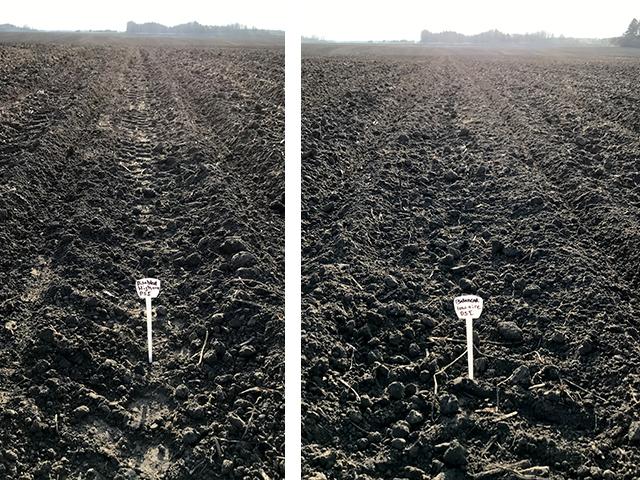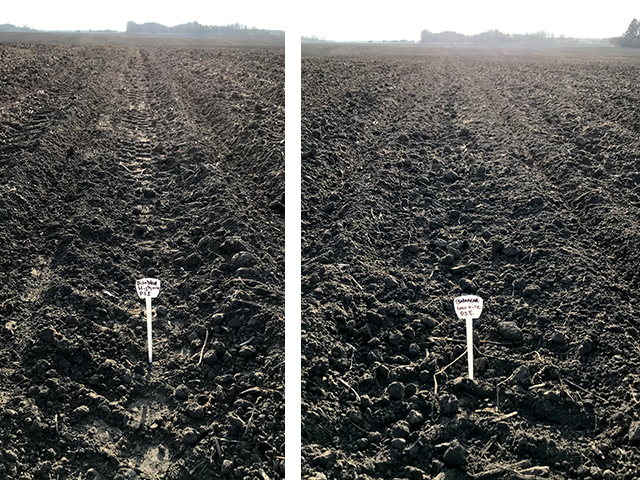MachineryLink
Battle Against Compaction
AGCO is doing interesting compaction fieldwork this summer to demonstrate its new Fendt Momentum planter and the effects of compaction on corn plant development and yield.
The AGCO Crop Tour series is in the middle of its fifth year. The program establishes demonstration plots across several states, comparing different planter settings, such as planting depth, seed singulation and row unit down-force with corn.
"We intentionally make mistakes ... we create skips and doubles, for example, and show the loss and cost from each," said Jason Lee, agronomy and farm solutions specialist for AGCO's Crop Care program involving application equipment, seeding and tillage.
The 2020 tour has added a new feature demonstrating the impact of compaction caused by central-fill planters on seedling establishment, plant growth and yield. The Momentum is a central-fill planter.
Lee pointed to research conducted by Pioneer in 2011 about the variability of corn yields associated with wheel traffic compaction across the width of a planter. Pioneer researchers found in that study (http://www.croppingcentralllc.com/…) that rows planted by the outside wing segments of planter in nine of 12 trial locations on average yielded 11.3 bushels more per acre more than yields from rows planted under center segments. All locations in the Pioneer study were planted in narrow rows of 20-22 inches. The impact of compaction may be greater in narrow rows, Pioneer concluded, than in 30-inch rows because narrow rows are closer to compacted wheel tracks in the interrow.
In a note, Pioneer found that central-fill planters "may exacerbate [compaction] by further concentrating wheel traffic weight in the center of the planter pass." In either case, Pioneer conceded at the time that, other than avoiding planting when soils are too wet, there was little growers can do to manage interrow compaction.
P[L1] D[0x0] M[300x250] OOP[F] ADUNIT[] T[]
AGCO contends its central-fill Momentum planter offers answers to inherent compaction issues not available almost a decade ago.
"Compaction is a well-known issue," Lee said. "In fact, some farmers won't fill their [planter center] tanks completely full to manage compaction. The consequences impact the crop in that year -- restricting root growth and reducing the availability of nutrients and water -- and beyond, maybe for decades."
AGCO's optional Load Logic system is a weight-management system designed to mitigate yield loss from tire compaction at planting by automatically and continually managing weight and tire pressure of all tires across the width of a Momentum planter. The planter's in-line tandem center transport wheels were equipped with high flexion tires.
Load Logic works in tandem with AGCO's VarioGrip technology. Where Load Logic manages compaction from the planter, VarioGrip manages compaction from the tractor. Having both, Lee said, offers a complete systems approach to compaction management.
AGCO's test plots will compare the effects of different tire pressure and weight-transfer settings on compaction management using the Load Logic system.
Load Logic can be set to automatic. In the field, as the planter begins to unfold, wheel pressure begins to adjust automatically, based on the weight carried on each tire. Monitored from the tractor cab, Load Logic can reduce each tire's pressure down to 15 psi while planting. For road travel, tire pressure is automatically adjusted upward to 55 psi.
"My eyes have been opened as to how much difference tire pressure makes," Lee said. Lower pressure extends a tire's footprint, reducing its contact pressure on the soil. Lee added in a release from AGCO, "It's really exciting to see how we can manage soil compaction from an equipment standpoint while still maintaining productivity with a high-capacity planter that can cover a lot of acres."
Lee awaits the harvest to record yield differences. However, AGCO agronomists have already deployed soil penetrometers to measure compaction in both the tractor and planter tire tracks compared to areas where there were no tire tracks from the tractor or planter. Penetrometers measure resistance in pounds per square inch as the device is slowly pushed into the ground, simulating a root penetrating soil. The more resistance to the penetrometer, the harder it will be for roots to grow and penetrate soil.
Readings were collected in five locations in Illinois, Ohio and South Dakota. The plots were planted with a Fendt Momentum planter equipped with the Load Logic system to manage the weight of the planter, seed and liquid fertilizer across all the planter's tires. The penetrometer tests recorded that the planter added no additional compaction to that already caused by the tractor tires when the planter was operating in Load Balanced mode. That's when the system distributes the weight evenly across all planter tires and the tire inflation system is set to auto -- low tire pressure is maintained but constantly adjusting.
"These initial results support our goal of not causing added compaction with the planter in order to give corn and soybean plants their best shot at optimum yields," Lee said in an AGCO release.
Dan Miller can be reached at dan.miller@dtn.com
Follow him on Twitter @DMillerPF
© (c) Copyright 2020 DTN, LLC. All rights reserved.






Comments
To comment, please Log In or Join our Community .